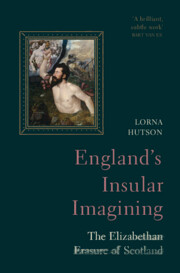Book contents
- England’s Insular Imagining
- England’s Insular Imagining
- Copyright page
- Contents
- Plates
- Abbreviations
- Acknowledgements
- Introduction
- Chapter 1 Writing the Forgotten War I: Henry’s War, 1542–1547
- Chapter 2 Writing the Forgotten War II: Somerset’s War, 1547–1550
- Chapter 3 How England Became an Island: The Faerie Queene
- Chapter 4 Scotland sui juris? Scottish Literature and the Marian Constitutional Crisis, 1567–1573
- Chapter 5 On the Knees of the Body Politic: Scottish Succession and English Liberties, 1567–1608
- Chapter 6 Scotland Un-kingdomed: English History on Stage
- Chapter 7 Race-Making in the Invention of Britain: The Masque of Blackness
- Chapter 8 Divisions and Kingdoms: Oedipal Britain from Gorboduc to King Lear
- Coda: Macbeth. ‘Alas, poor country’
- Works Cited
- Index
- Plate Section (PDF Only)
Chapter 6 - Scotland Un-kingdomed: English History on Stage
Published online by Cambridge University Press: 28 September 2023
- England’s Insular Imagining
- England’s Insular Imagining
- Copyright page
- Contents
- Plates
- Abbreviations
- Acknowledgements
- Introduction
- Chapter 1 Writing the Forgotten War I: Henry’s War, 1542–1547
- Chapter 2 Writing the Forgotten War II: Somerset’s War, 1547–1550
- Chapter 3 How England Became an Island: The Faerie Queene
- Chapter 4 Scotland sui juris? Scottish Literature and the Marian Constitutional Crisis, 1567–1573
- Chapter 5 On the Knees of the Body Politic: Scottish Succession and English Liberties, 1567–1608
- Chapter 6 Scotland Un-kingdomed: English History on Stage
- Chapter 7 Race-Making in the Invention of Britain: The Masque of Blackness
- Chapter 8 Divisions and Kingdoms: Oedipal Britain from Gorboduc to King Lear
- Coda: Macbeth. ‘Alas, poor country’
- Works Cited
- Index
- Plate Section (PDF Only)
Summary
Shakespeare’s Henry V shapes popular consciousness of England/Britain at war, yet resists accusations of jingoism. Its national imagining involves conscientious doubts about the justice of war itself. Chapter 5 shows that this appealingly inward, conscientious dimension of English national identity on stage is predicated on Scotland’s occlusion. Scotland was a major player in the Hundred Years’ War. Henry IV kidnapped the child heir to the Scots throne, James I. Henry V then forced James to fight his subjects, the Scots, in France. Yet Shakespeare carefully avoids acknowledging Scotland as a kingdom. He develops, from earlier history plays, a metaphorical plot that produces the idea of England’s island integrity as an effect of its king’s chaste reformation. In this plot, England is threatened by the wild incontinence of its royal heir until his reformation effectively secures England’s insularity, enabling English advancement ‘beyond sea’ to France. The analogy between royal self-chastening and English insular sea-power is traced through Greene’s Bacon and Bungay, Marlowe’s Edward II, the anonymous Edward III to Henry IV 1 & 2 and Henry V.
- Type
- Chapter
- Information
- England's Insular ImaginingThe Elizabethan Erasure of Scotland, pp. 188 - 219Publisher: Cambridge University PressPrint publication year: 2023



